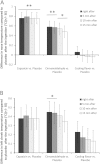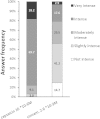Effects of TRP channel agonist ingestion on metabolism and autonomic nervous system in a randomized clinical trial of healthy subjects
- PMID: 26883089
- PMCID: PMC4756362
- DOI: 10.1038/srep20795
Effects of TRP channel agonist ingestion on metabolism and autonomic nervous system in a randomized clinical trial of healthy subjects
Abstract
Various lines of published evidence have already demonstrated the impact of TRPV1 agonists on energetic metabolism through the stimulation of the sympathetic nervous system (SNS). This study presents a trial investigating if stimulation of the two related sensory receptors TRPA1 and TRPM8 could also stimulate the SNS and impact the energetic metabolism of healthy subjects. The trial was designed to be double-blinded, randomized, cross-over, placebo-controlled with healthy subjects and the impact on the energetic metabolism and the autonomic nervous system (ANS) of cinnamaldehyde, capsaicin and a cooling flavor was measured during the 90 min after ingestion. Energy expenditure and substrate oxidation were measured by indirect calorimetry. An exploratory method to measure ANS activity was by facial thermography and power spectral analysis of heart rate variability using ECG was also used. Following cinnamaldehyde ingestion, energy expenditure was increased as compared to placebo. Furthermore, postprandial fat oxidation was maintained higher compared to placebo after cinnamaldehyde and capsaicin ingestion. Similar peripheral thermoregulation was observed after capsaicin and cinnamaldehyde ingestion. Unlike capsaicin, the dose of cinnamaldehyde was not judged to be sensorially 'too intense' by participants suggesting that Cinnamaldehyde would be a more tolerable solution to improve thermogenesis via spicy ingredients as compared to capsaicin.
Trial registration: ClinicalTrials.gov NCT02193438.
Figures






Similar articles
-
TRPV1 and TRPA1 stimulation induces MUC5B secretion in the human nasal airway in vivo.Clin Physiol Funct Imaging. 2011 Nov;31(6):435-44. doi: 10.1111/j.1475-097X.2011.01039.x. Epub 2011 Jul 26. Clin Physiol Funct Imaging. 2011. PMID: 21981454 Clinical Trial.
-
TRPA1 and TRPV4 activation in human odontoblasts stimulates ATP release.J Dent Res. 2014 Sep;93(9):911-7. doi: 10.1177/0022034514544507. Epub 2014 Jul 25. J Dent Res. 2014. PMID: 25062738 Free PMC article.
-
TRPV1-mediated itch in seasonal allergic rhinitis.Allergy. 2009 May;64(5):807-10. doi: 10.1111/j.1398-9995.2009.01937.x. Epub 2009 Feb 13. Allergy. 2009. PMID: 19220220
-
Potential therapeutic value of TRPV1 and TRPA1 in diabetes mellitus and obesity.Semin Immunopathol. 2016 May;38(3):397-406. doi: 10.1007/s00281-015-0529-x. Epub 2015 Sep 24. Semin Immunopathol. 2016. PMID: 26403087 Free PMC article. Review.
-
TRPV1, TRPA1, and TRPM8 channels in inflammation, energy redirection, and water retention: role in chronic inflammatory diseases with an evolutionary perspective.J Mol Med (Berl). 2014 Sep;92(9):925-37. doi: 10.1007/s00109-014-1175-9. Epub 2014 May 29. J Mol Med (Berl). 2014. PMID: 24871046 Review.
Cited by
-
The impact of dietary factors on the function of brown and beige adipose tissues-implications on health and disease.Front Nutr. 2025 Aug 4;12:1626068. doi: 10.3389/fnut.2025.1626068. eCollection 2025. Front Nutr. 2025. PMID: 40832640 Free PMC article. Review.
-
Sex differences in estimates of cardiac autonomic function using heart rate variability: effects of dietary capsaicin.Eur J Appl Physiol. 2023 May;123(5):1041-1050. doi: 10.1007/s00421-023-05136-0. Epub 2023 Jan 12. Eur J Appl Physiol. 2023. PMID: 36633663
-
Royal Jelly Plus Coenzyme Q10 Supplementation Enhances High-Intensity Interval Exercise Performance via Alterations in Cardiac Autonomic Regulation and Blood Lactate Concentration in Runners.Front Nutr. 2022 Jun 23;9:893515. doi: 10.3389/fnut.2022.893515. eCollection 2022. Front Nutr. 2022. PMID: 35811968 Free PMC article.
-
Cinnamaldehyde supplementation acts as an insulin mimetic compound improving glucose metabolism during adolescence, but not during adulthood, in healthy male rats.Hormones (Athens). 2023 Jun;22(2):295-304. doi: 10.1007/s42000-023-00442-w. Epub 2023 Feb 22. Hormones (Athens). 2023. PMID: 36810755
-
Mammalian cold TRP channels: impact on thermoregulation and energy homeostasis.Pflugers Arch. 2018 May;470(5):761-777. doi: 10.1007/s00424-018-2145-9. Epub 2018 Apr 26. Pflugers Arch. 2018. PMID: 29700598 Review.
References
-
- Donahoo W. T., Levine J. A. & Melanson E. L. Variability in energy expenditure and its components. Curr Opin. Clin Nutr Metab Care 7, 599–605 (2004). - PubMed
-
- Hursel R. & Westerterp-Plantenga M. S. Thermogenic ingredients and body weight regulation. Int. J. Obes. (Lond) 34, 659–669 (2010). - PubMed
-
- Matsumoto T. et al. Effects of capsaicin-containing yellow curry sauce on sympathetic nervous system activity and diet-induced thermogenesis in lean and obese young women. J Nutr Sci. Vitaminol. (Tokyo) 46, 309–315 (2000). - PubMed
Publication types
MeSH terms
Substances
Associated data
LinkOut - more resources
Full Text Sources
Other Literature Sources
Medical

